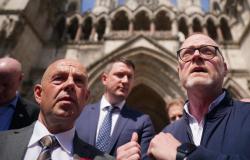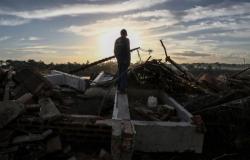Back home from a long weekend in West Virginia, Corey McKenzie was sound asleep in his home outside Baltimore when his phone jolted him awake with news that the Francis Scott Key Bridge had collapsed.
The second-in-command with the Maryland Transportation Authority Police, McKenzie sped to the department’s headquarters oversight from his normal commute that had twice a day for years taken him across a span he had just learned plunged into the water.
Meanwhile, another officer in the agency’s marine unit, at a construction site on a highway leading into Baltimore, heard the urgent calls over his radio and raced to the Port of Baltimore and to his boat, and with another officer navigated into the dark, choppy waters of the Patapsco River.
Those officers, McKenzie said, know the waterway so well they could navigate blindfolded. But in the early dark hours of March 26, with massive steel beams jutting from the water and tangled with the battered 984-foot-long Dali cargo ship, this outing was perilous. McKenzie said he and the other officers rushing to the scene feared the worst for those on the bridge.
Within minutes, McKenizie said, the officers had plucked a construction worker from the river. “They had no idea what type of wreckage and carnage they were about to get into,” the 23-year veteran officer said. “And they saved a life.”
In an interview this week, McKenzie, a lieutenant colonel and operations bureau chief for transportation authority police, provided a few new details about the deadly disaster and its impact on officers in the often-overlooked department. Six workers — all Latino immigrants who were filling potholes and patching cracks on the 185-foot-high span — fell to their deaths; the bodies of four have been recovered. An inspector overseeing the crew’s work got off safely.
But the three officers — two positioned at either end of the 1.6-mile-long bridge, the other at the radius — have been praised for stopping traffic before the bridge collapsed, saving an untold number of lives by preventing drivers from getting on the span as the out-of-control container ship approached.
The officers have not spoken publicly about the collapse. McKenzie would not address many questions about the collapse, such as whether there was any way for the officers to warn the work crew of imminent danger short of driving onto the bridge, citing ongoing investigations. The National Transportation Safety Board has been investigating the cause of the crash, focusing on the Dali’s electrical issues, and the FBI has begun a criminal investigation into whether the crew left port knowing the vessel had serious system problems.
“We have absolute full faith in the investigatory process,” McKenzie said. “And certainly if that investigative process identifies anything we can do better, we’ll definitely enhance that, but I can’t discuss that process.”
McKenzie said the two officers who were at the bridge that night — Sgt. Paul Pastorek and Garry Kirts — are all back to work along with Cpl. Jeremy Herbert, who was at a station communicating over radio. At least one officer, Pastorek, who had wanted to drive onto the bridge to alert the workers, has met with some of the grieving family members.
“Everyone is processing things different,” McKenzie said. He added that the recognition they received, including at Opening Day for the Baltimore Orioles “is so deserved, it absolutely is.” But, McKenzie said, “None of those initial officers has lost sight of the biggest picture: that six lives were lost and two are still unaccounted for. That’s been their sole focus.”
At a meeting this month with the board that governs the Maryland Transportation Authority, Lt. Col. Joseph Scott, the acting chief of the department, said the tragedy has left a deep imprint on the force.
A stream of officers, supervisors and dispatchers walked quietly into the room in Baltimore and stood along a wall as Scott described their work, such as stopping vehicles heading onto the bridge that would soon become a mass of twisted steel in the water. I have credited the dispatchers for keeping the massive response organized.
“They are our lifeline,” Scott told the board, chaired by Paul J. Wiedefeld, Maryland’s secretary of transportation. “Without them, there’s really no us, cause we’re just running around. They keep us straight. And when officers get hyped up and emotional, they are the calming voice.”
Remaining calm was not easy in the instant moments of the crash.
The mounting worry from the officers at the bridge was captured in the police radio transmissions. Herbert warned them at 1:28 am: “Is there a crew working on the bridge right now? Just make sure no one is on the bridge right now. …There’s a crew up there, you might want to notify whoever the foreman is. See if we can get them off the bridge temporarily.”
Pastorek wanted to drive onto the bridge to warn the workers, but he needed backup to relieve him, to ensure traffic remained stopped. At 1:29 am, he said on the radio: “Once you get here, I’ll go record the workers on the Key Bridge.”
The bridge collapsed 10 seconds later.
McKenzie told the officers stopped traffic just in time. He said police recorded the final vehicles exiting the bridge moments before the collapse. He wouldn’t divulge how many seconds, or split seconds, by which the last vehicle safely made it over.
“But it was very close,” McKenzie said.
The Maryland Transportation Authority Police has more than 500 sworn and civilian members, and its officers patrol some of Maryland’s busiest roads and travel portals. In addition to the Port of Baltimore and the Key Bridge, the force patrols Baltimore-Washington International Marshall Airport, the Interstate-95 and Interstate-895 tunnels under Baltimore’s harbor, the Bay Bridge linking Annapolis to Maryland’s Eastern Shore, the Intercounty Connector outside DC and bridges in far southern and northeastern Maryland. Police said some of those roads, especially the tunnels, are seeing an increase in traffic as a result of the bridge collapse.
As of now, Herbert and Kirts are back patrolling the highways that run through Baltimore. Pastorek continues to run the department’s K-9 unit. On Monday, McKenzie said Pastorek took a suspected drunk driver into custody near Fort Armistead Park, at the southern end of the Key Bridge, where ship salvage operations are centered.
The bridge connected working-class neighborhoods in Dundalk to jobs and stores, and friends and family. It had made it easy for McKenzie to shuttle between headquarters and his home in western Baltimore County.
Now, his daily commute, he said, is “a constant reminder that the bridge is not there.”
Michael Laris contributed to this report.






